![[EAI Issue Briefing on Public Opinion No. 92] Ambivalence toward North Korea: South Korean Public Perceptions Following the Attack on Yeonpyeong Island](../images/bg_tmp.jpg)
[EAI Issue Briefing on Public Opinion No. 92] Ambivalence toward North Korea: South Korean Public Perceptions Following the Attack on Yeonpyeong Island
Global NK Zoom & Connect | Commentary·Issue Briefing | 2011-01-17
Nae-young Lee · Han-wool Jeong
EAI Issue Briefing on Public Opinion No. 92
Introduction
In 2010 there were two major North Korean provocations against South Korea as tensions mounted on the Korean Peninsula and in the broader region. Following both the sinking of the ROK Navy corvette Cheonan and the artillery attack on Yeonpyeong Island, there has been a process within South Korean society to clarify where the responsibility lies and to find an appropriate direction for coping with a more aggressive North Korea. The way that politicians and the media have analyzed the situation has mostly been based upon a dichotomy of ‘war vs. peace.’ Public opinion on the other hand has displayed ambivalent attitudes toward war or peace, preferring to allow for both concepts to exist rather than choosing one over the other.
The South Korean public does not support either appeasement policies that hold back from retaliation or hard line policies that could lead to a full-scale war. In the short term, the public shows mixed views toward improving inter-Korean relations. For the long term, however, the majority of the public favors that the government redirects its tough stance against North Korea toward more dialogue and cooperation. However, it should be noted that there is a growing opinion for maintaining hard-line policies against North Korea even for the long term.
The EAI and Hankook Research, as part of its monthly Public Opinion Barometer, surveyed eight hundred people from around South Korea on November 27, 2010, four days after the attack on Yeonpyeong Island. The results of the November Public Opinion Barometer survey formed the basis of the EAI Issue Briefing on Public Opinion entitled “The Impact of North Korea’s Artillery Strike on Public Opinion in South Korea” which summed up the characteristics of public opinion after the incident . This Issue Briefing will use the results from that survey to provide analysis of the shifting public perceptions on policies toward North Korea.
Issues Regarding Public Opinion on the Yeonpyeong Attack
In the aftermath of the artillery strike on Yeonpyeong Island, there have been many discussions among political and civilian sectors of society. The major issues related to the attack include: (1) cause and responsibility, (2) evaluation of Seoul’s response, (3) levels of possible military retaliation, and (4) future policy toward North Korea.
Table 1 Issues Regarding Public Opinion on the Yeonpyeong Attack
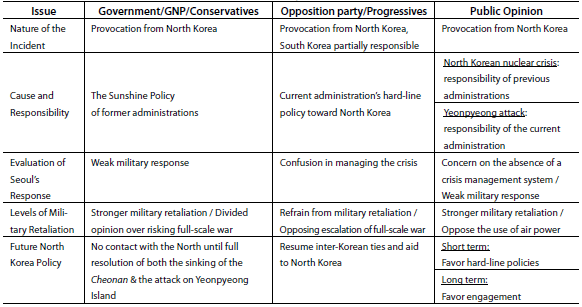
1. Cause and Responsibility of the Incident
The main difference between North Korea’s provocations in 2010 is in its admission of culpability. Whereas Pyongyang strenuously denied any involvement in the sinking of the Choenan, it openly and publically admitted that its artillery forces attacked Yeonpyeong Island. Thus, for the Yeonpyeong attack there have been no different views on the direct cause as was seen in the aftermath of the Cheonan sinking. Still, responsibility in preventing the deadly artillery attack shows a divide among public opinion. According to the EAI/Hankook Research November Opinion Barometer survey, a majority believes that the policies of the current Lee Myung-bak administration are responsible for provoking the Yeonpyeong attack. But when asked on the North Korean nuclear crisis, most place responsibility on the previous Kim Dae-jung (1998-2003) and Roh Moo-hyun (2003-2008) administrations.
In the November Public Opinion Barometer survey, when asked which administration’s policy resulted in the Yeonpyeong attack, 39.4% of respondents blamed the Sunshine Policy of the former administrations while 51.3% blamed the current administration’s hard-line policy against North Korea. The majority of the younger generation, well-educated groups, and progressives criticized the current administration while most of the older generation, low-income groups, and conservatives accused the previous administrations.
In another survey conducted on the same day by the Asan Institute for Policy Studies and Research & Research, the results showed a different perception on the North Korean nuclear crisis. 43.3% of respondents blamed the Kim Dae-jung and Roh Moo-hyun administrations’ Sunshine Policy while 35.5% accused the current administration’s hard-line policies.
What lies behind the two different perceptions concerning the North Korean nuclear crisis and the attack on Yeonpyeong Island? It would be obvious to point out that this is simply because the two events occurred under the watch of each respective administration. However, tracking back to the root of this issue there is a critical perception by the public on the government’s inability to prevent North Korea from developing nuclear weapons during the ten years of the Sunshine Policy. At the same time, there is deep unhappiness with the current administration’s reluctance to engage the North, which has caused strains in inter-Korean relations.
Figure 1 Where the Responsibility Lies for Yeonpyeong Attack and North Korean Nuclear Crisis
Who is responsible for Yeonpyeong Attack?
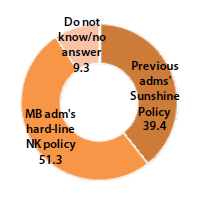
Who is responsible for North Korean Nuclear Crisis? Problem?
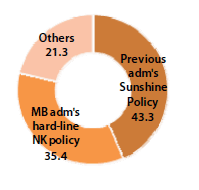
2. Evaluation of Seoul’s Response to the Attack on Yeonpyeong Island
According to the November Public Opinion Barometer survey, the majority of South Korean citizens have a high level of distrust in their government. As was already presented in “The Impact of North Korea’s Artillery Strike on Public Opinion in South Korea,” only 24.7% of respondents believed that the government responded well while 72.0% believed that the government did wrong. Likewise, the Asan Institute for Policy Studies/Research & Research survey reveals that only 25.9% of respondents had a positive view on the government’s response while 65.7% held a negative view.
On the subject of what the government did wrong, the results of the November Public Opinion Barometer survey shows that supporters of the Grand National Party (GNP) which is the current ruling party, Liberty Forward Party and other conservatives felt that it was the government’s limited retaliation compared to the level of damage sustained on Yeonpyeong Island. On the other hand, the opposition party and progressives pointed out that the government failed in its handling of the crisis.
Overall, the largest number of respondents (36.5%) placed blame on the government’s lack of an effective crisis management system, while 23.8% stated that the military response was too weak. Other responses included, 13.1% who thought that the direction of response was confused, 11.4% who thought that there was confusion in official statements made by the government, and 6.9% answered that the absence of diplomacy with China was wrong.
Figure 2 Different Reasons for Criticism by Ideological Background
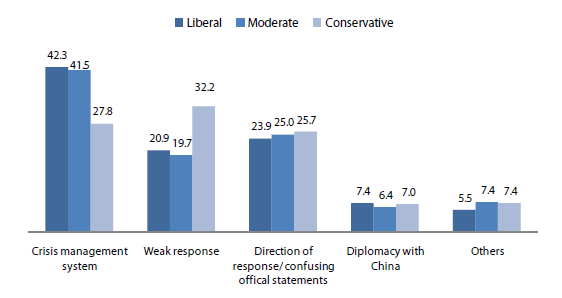
3. Levels of Possible Military Measures
The biggest change in the public perception towards North Korea after the Yeonpyeong attack is the acceptance of the military option to counter North Korea’s actions. 68.6% of respondents answered that a military option was an appropriate countermeasure against North Korea’s attack on Yeonpyeong Island while only 23.9% were against this. This number (68.6%) has more than doubled when compared to the number in the May Public Opinion Barometer survey conducted following the sinking of the Cheonan which was a mere 28.2%.
South Korean public opinion is beginning to form a common perception that the government’s military response was weak. According to the data from the Asan Institute for Policy Studies survey, 80.3% of respondents agreed that the South Korean military should have taken stronger action against North Korea during the Yeonpyeong attack.
However, according to the results of the EAI/Hankook Research survey, the public felt that it would have been too dangerous to have used close air support to attack North Korean artillery positions during the shelling of Yeonpyeong Island. Such measures could have brought the situation to the brink of all-out war. On these issues, respondents were asked if “South Korea should have launched air strikes on North Korean artillery positions” or whether “South Korea should have refrained from using air power in order to prevent escalation.” 39.3% supported the use of air power while 56.6% answered that refraining from launching air strikes was appropriate. This clearly shows that while more people prefer to take up hard-line policies toward North Korea following the Yeonpyeong attack, the majority does not favor any actions that might lead to a full-scale war with North Korea.
Figure 3 Pros & Cons Concerning the Use of Air Strikes during the Yeonpyeong Attack
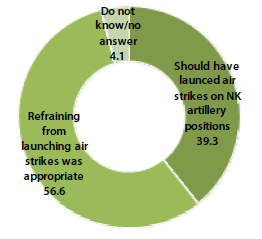
4. Future Policy towards North Korea
Calls within South Korea to minimize or even cut off aid to North Korea are becoming more vocal. According to the Public Opinion Barometer conducted in January 2010, 67.6% of respondents felt that it was necessary to increase or maintain current levels of aid to North Korea with only 31.6% believing it should be minimized or abolished. However, the number of respondents who believe that aid to North Korea should be maintained or even increased is decreasing. The Public Opinion Barometer surveys conducted by the EAI and Korea Research following both the Cheonan incident (May 2010) and the attack on Yeonpyeong Island (November 2010) showed those in support of aid at 41.8% and 40.5% respectively. On the other hand, the number of those who agreed to minimize or cut off aid are in the majority, going from 51.2% (May, 2010) to 56.9% (November, 2010).
Although short term public support for aid policies to North Korea has decreased, in terms of long term policies there is still strong support for reconciliation and cooperation rather than maintaining hard-line policies. In the May Public Opinion Barometer, only 37.1% felt that South Korea should pursue hard-line policies toward North Korea in the long run. This number increased slightly to 42.7% following the Yeonpyeong Island attack. By contrast, the percentage of people who supported reconciliation and cooperation with North Korea in May 2010 was 61.5% and only decreased by 6.3% points (55.2%) in November, 2010. While it is true that more people are beginning to favor hard-line policies even for the long term, a far larger percentage still prefers engagement policies with North Korea.
Figure 4 Public Opinion on Aid to North Korea & Long Term Policies toward North Korea
Aid to North Korea Long Term Policy toward North Korea
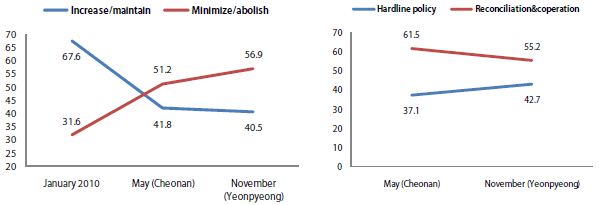
Conclusion
There has been a fundamental change in public opinion on policies toward North Korea after the sinking of the Cheonan and the artillery strike on Yeonpyeong Island. These two incidents have broken the societal consensus on the policies of reconciliation and cooperation, which was mainly focused on providing aid to North Korea. The military option, which was unthinkable in the past, is now seriously considered as a reasonable response by the majority of the public. South Korean public opinion which favored patience for the future in the face of past provocations now supports military countermeasures. There are also more voices blaming the Sunshine Policy under the previous administrations for allowing North Korea to develop nuclear weapons.
However, this does not mean that the public has turned their back completely on engagement policies in favor of tougher policies against North Korea. The public remain concerned that a hard-line approach might escalate the situation and lead to an all-out war. For this reason there is still support for reconciliation and cooperation with North Korea in the long run. That is to say, even though the public’s center of gravity might edge toward tougher policies, contradicting attitudes will continue to exist within public perceptions.
In devising new policies toward North Korea, a flexible approach should be considered that does not select either a hard-line approach or engagement. Such a hybrid policy will gain more public support in the near future.■
Center for North Korea Studies
Global NK Zoom & Connect
Global NK Zoom & Connect
![[ADRN Issue Briefing] Decoding India’s 2024 National Elections](/data/bbs/eng_issuebriefing/20240419123938102197065(1).jpg)
Commentary·Issue Briefing
[ADRN Issue Briefing] Decoding India’s 2024 National Elections
Niranjan Sahoo | 2011-01-17
![[ADRN Issue Briefing] Inside the Summit for Democracy: What’s Next?](/data/bbs/eng_issuebriefing/2024032815145548472837(1).jpg)
Commentary·Issue Briefing
[ADRN Issue Briefing] Inside the Summit for Democracy: What’s Next?
Ken Godfrey | 2011-01-17